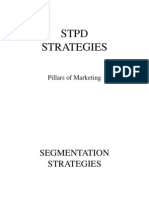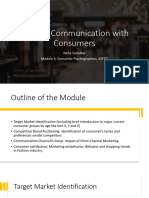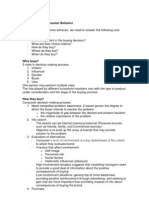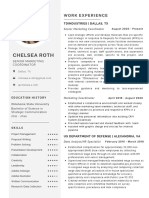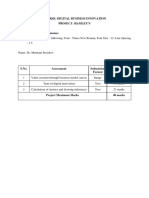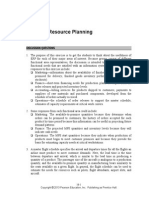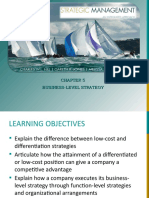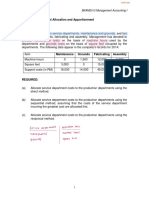Who is important? How do they buy? What are their choice criteria?
Customers
Where do they buy?
When do they buy?
Understanding customers : the key questions
�What is consumer behaviour
Study of how the individuals ,groups or organisations select, buy, use and dispose of goods, services, ideas or experiences to satisfy their needs
�Factors influencing consumer behaviour
Cultural factors Social factors Personal factors
Age and stage in the life cycle Occupation & economic circumstances Personality & self concept Lifestyle & values
�Brand personality
Sincerity (down-to-earth, honest, wholesome and cheerful) Excitement (daring, spirited, imaginative & up-to-date) Sophistication (upper-class & charming) Ruggedness (out doorsy & tough)
E:gLevis-ruggedness MTV- Excitement CNN-competence
�Reference groups
Membership groups
Primary group Secondary group
Aspirational group Dissociative group
�Buying roles
INITIATOR
INFLUENCER PAYER DECIDER BUYER USER
�Consumer buying process
Need recognition & Problem awareness Information search Evaluation of alternatives Purchase decision Post-purchase behavior
�Need recognition
Internal Stimulus
External Stimulus
Routine needs Evolved needs Emergency needs
Which product to buy?
�Information search
Which brand to buy?
Internal Retrieving information from sources memory
sources
External sources
Personalfamily,friends,neighbours,acquintances
Commercial-advert, web-site, sales-persons
Public- mass media, consumer rating organisation Experiential-handling, examining, using the product
�Entire Set Of Brands Available Or known
Evoked set Consideration Set Inert set Inept set
Choice set
�Market segmentation
Dividing a market into distinct groups with Distinct needs Distinct characteristics or behavior who might require separate products or marketing mixes.
�Why segmentation
Through market segmentation, companies divide large, heterogeneous
markets into smaller segments that can be reached more effectively
and efficiently with products and services that match their unique needs
�Bases of segmentation
Age & Lifecycle
Demographic-
Gender Life stages occupation
Geographic-
Urban Rural etc.
Behavioral-
Benefits sought Purchase occasion Brand loyalty Usage Perception& beliefs
Psychographic- Lifestyle
Personality
�Strategies of segmentation
Niche - marketing One product one market strategy
One product, with different variations in the product but catering to the needs of different market segments Different products catering to the needs of one consumer segment.
One product many market
Many product one market Multiple niching
Many product many market
�Market segmentation 1.Identify bases for segmenting the market. 2. Develop segment profiles.
Target marketing
3.Develop measure of segment attractiveness 4. Select target segments
Market positioning 5. Develop positioning for target segments. 6. Develop a marketing mix for each segment.
�Market segmentation Company identifies different ways
to segment the market. & Develop profiles of the resulting market segments
Target marketing- evaluating each market segments
attractiveness
& Selecting one or more of the market segments to enter.
Marketing positioning- setting the competitive positioning for
the product & creating a detailed marketing mix
�Target market
A target market is a group of people or organisations for which a company Designs Implements and Maintains a marketing mix intended to meet the needs of that group, resulting in mutually beneficial and satisfying exchanges.
�Product positioning
The way the product is defined by consumers on important attributes the place the product occupies in consumers minds relative to competing products.
A products position is the complex set of Perception Impression & Feeling
That the consumers have for the product compared with competing product
�Result of positioning
Customer- focused value proposition
A cogent why the target market should buy the product
Positioning is: Not what you do to a product . But what you do to the minds of the prospect.
�Company & product
Perdue (chicken)
Target customers
Qualityconscious consumers of chicken.
Benefits
price
Value proposition
More tender golden chicken at a moderate premium price
Tenderness
10% premium
Volvo (station wagon)
Dominos (pizza)
Safetyconscious upscale families. Convenienceminded pizza lovers
Durability and safety
20% premium
The safest, most durable wagon in which your family can ride.
Delivery speed and good quality
15% premium
A good hot pizza,delivered to your door within 30 minutes of ordering at a moderate price.
�Choosing a positioning strategy
Three steps: Identifying a set of possible competitive advantages upon which to build a position Choosing the right competitive advantages Selecting an overall positioning strategy
The company must effectively communicate and deliver the chosen position to the market
�Decision on positioning requires determining the
Competitive frame of reference by identifying
The target market The competition &
Identifying the
The ideal points-of-parity (POP) The points-of-difference (POD)
�CATEGORY MEMBERSHIP
the products or set of products with which a brand competes & which functions as a close substitutes Target market Buyer behavior Identify the consideration set consumer use in making brand choices Buying roles
�Point-of-difference (PODs)
Attributes and benefits consumers strongly associate with a brand , positively evaluate, and believe that they could not find to the same extent with a competitive brand.
Point-of-parity (POPs)
Associations that are not necessarily unique to the brand but may infact be shared with other brand.
Category POPs Competitive POPs
�Category point- of- parity Associations consumers view as essential to be a legitimate and credible offering within a certain product or service category They represent necessary- but not necessarily sufficient-conditions for brand choice Competitive point-of-parity
Associations designed to negate competitors points-of-difference
�Choosing POPs & PODs
Relevance Distinctiveness Believability There are three deliverability criteria Feasibility
Communicability
Sustainability




